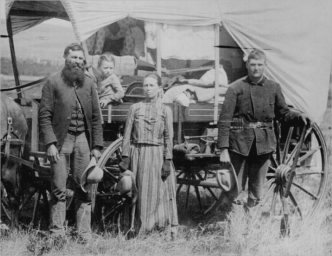Outdoor skills we can learn from the 19th century Wild West settlers

The life in the American Wild West was nothing like it has been portrayed by the Hollywood western classics. The people of the west did not live like Clint Eastwood and John Wayne would have us believed; however, this does not mean the western experience is not worth mentioning as it contains the plethora of interesting paraphernalia that helps one understand the intricacies of life in the west.
Settlers making the great move to the promising land in the west were forced by the ambitions of living a life in the open away from the hustle; the life that brought with it more challenges then comfort.
One interesting fact that people living in the west quickly learnt to adhere to was the attaining and storing of food items as this was the single most important survival factor that really mattered in the west.
Attaining Food
For the settlers, there were two primary indigenous food sources namely the local meat and vegetation they grew in their farms. The meat was attained purely by the means of hunting that required certain skill sets that the folks in the west quickly acquired considering the amount of hunt available during those days.
The 19th century was a particularly great period for hunting, not so for the locals but for the commercial hunters mainly, as millions of wild buffalo roamed across the plains freely.
Local people hunted buffalo and squirrel for their meat, and the thought of scarcity of meat never crossed the minds of the people due to the abundance of the wild buffalo. From the year 1830 to 1889 the population of buffalo in the western plains dramatically decreased from a whopping 40 million to a mere 541, all as a result of mass-scale commercial hunting.
The early settlers grew food in their garden as well and considered it as one of their top most priorities. They planted a wide variety of vegetables in their farms and gardens including beans, squash, sweet potatoes, peas, potatoes along with onions, melons, and cucumbers.
The kitchen garden of the old west was planted twice a year much like how it is done today. The early spring would bring to the settlers, peas and cabbages, while the garden would provide enough food that grew in the later summer, to keep their tables occupied all through the winter months.
Apart from the home grown vegetables the settlers had at their disposal plenty of wild plants such as wild onions, dandelions as well as various salad leaves. In places like Montana, people enjoyed a wide variety of wild fruits such as huckleberries and chokeberries. Corn was also a big part of life in the West, especially in the regions such as Kansas, Dakota, South Colorado and Arizona.
Storing the Food
Frontier people had a number of tricks and techniques to preserve their food and to keep themselves fed all through the year. The methods were frequently deployed to store both the vegetables and meat to make them last longer without fearing a shortage in the winters.
Pickling was an important technique for the preservation of Vegetables and provided ample pickled vegetables during the winter period. Drying was another method wherein large portions of vegetable were exposed to sun light and were dried out over a period of few days.
More efforts and expertise were required when it came to preserving the meat, though, as the process of storing the meat practically started right after the animal was killed. The most widely used methods were salting and drying; the meat was left to dry for weeks after being sliced into small pieces; after the initial drying the meat would be then dipped in brine and was left to dry again in a cool, dry place away from the insects and flies.
